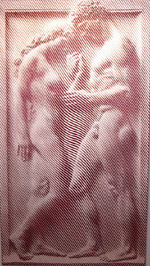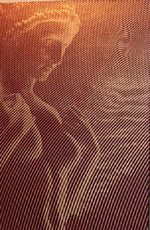Егор Остров. Глубина резкости. Егор Остров и Арно Брекер (живопись).
 Куратор — Иван Чечот. Известный петербургский художник Егор Остров (род. 1972 г.) представляет на выставке серию из двадцати крупноформатных живописных работ, являющихся результатом переработки фотографий монументальных скульптур Арно Брекера с помощью ритмизированного, волнистого растра. В этом проекте художник продолжает варьировать способы употребления и согласования цветного растра с формой и ритмом фото-репродукционного мотива, заимствованного из истории искусства, прежде всего фигуративного и классического. Настоящая серия вводит в игру не просто мотивы классической скульптуры и живописи, как это уже не раз бывало в творчестве Острова. Она обращает внимание публики на произведения Арно Брекера (1900 – 1991) – скандально знаменитого «придворного художника» Адольфа Гитлера, выдающегося мастера неоклассической традиции, виртуоза монументальной мраморной скульптуры, автора грандиозной портретной галереи деятелей европейской культуры и экономики 20 века. Егор Остров обращается к Брекеру в художественном и эстетическом контексте, политическая роль скульптора его не интересует.
Куратор — Иван Чечот. Известный петербургский художник Егор Остров (род. 1972 г.) представляет на выставке серию из двадцати крупноформатных живописных работ, являющихся результатом переработки фотографий монументальных скульптур Арно Брекера с помощью ритмизированного, волнистого растра. В этом проекте художник продолжает варьировать способы употребления и согласования цветного растра с формой и ритмом фото-репродукционного мотива, заимствованного из истории искусства, прежде всего фигуративного и классического. Настоящая серия вводит в игру не просто мотивы классической скульптуры и живописи, как это уже не раз бывало в творчестве Острова. Она обращает внимание публики на произведения Арно Брекера (1900 – 1991) – скандально знаменитого «придворного художника» Адольфа Гитлера, выдающегося мастера неоклассической традиции, виртуоза монументальной мраморной скульптуры, автора грандиозной портретной галереи деятелей европейской культуры и экономики 20 века. Егор Остров обращается к Брекеру в художественном и эстетическом контексте, политическая роль скульптора его не интересует. В то же время своими работами Остров стремится воздать должное Брекеру как художнику и эстету и привлечь внимание публики к своеобразной холодной красоте его изысканных произведений. Название выставки многозначно; оно призвано привлечь внимание к нюансам эстетики «резкого», очень резкого и мягкого, к проблематике «глубокого» и скрытого и поверхностного, к противоречивости соединения этих моментов как в замыслах и работах Егора Острова, так и в искусстве и судьбе Арно Брекера. Работы Егора Острова соединяют в одном контексте и на одной плоскости скульптуры, фотографии и живопись с применением новейших технических приемов. Здесь 30-40-у годы, идеалы и моды времен Второй мировой войны встречаются с модами и техникой, с ностальгией по классической красоте в начале 21 века. Картины Острова фигурируют также в качестве скульптур, и для отечественной публики они во многом будут первым знакомством с пластикой Брекера. Фотографии, положенные в основу работ Острова, были выполнены до и во время войны выдающимся мастером фотоискусства Шарлоттой Рорбах. Эти шедевры искусства светотени были созданы в связи с экспозицией произведений Брекера в Париже в 1942 г., для монографии о немецком мастере, составленной известным французским скульптором Шарлем Деспио. Параллельно с выставкой в галерее Д137 по соседству, в доме 10 по Пушкинской улице в галерее Navicula Artis будет открыта небольшая выставка фотографий с произведений Арно Брекера, снятых И.Д.Чечотом в музее Брекера в замке Нервених близ Бонна и в других местах Германии. На этой выставке можно будет также увидеть литературу о скульпторе, в том числе и из коллекции Т.П.Новикова, который выступал одним из первых пропагандистов творчества Брекера в современной России. В рамках обоих выставок состоится вечер и дискуссия, посвященные Брекеру, нео-академизму, а также проблемам диалога с классической традицией в современном искусстве.
В то же время своими работами Остров стремится воздать должное Брекеру как художнику и эстету и привлечь внимание публики к своеобразной холодной красоте его изысканных произведений. Название выставки многозначно; оно призвано привлечь внимание к нюансам эстетики «резкого», очень резкого и мягкого, к проблематике «глубокого» и скрытого и поверхностного, к противоречивости соединения этих моментов как в замыслах и работах Егора Острова, так и в искусстве и судьбе Арно Брекера. Работы Егора Острова соединяют в одном контексте и на одной плоскости скульптуры, фотографии и живопись с применением новейших технических приемов. Здесь 30-40-у годы, идеалы и моды времен Второй мировой войны встречаются с модами и техникой, с ностальгией по классической красоте в начале 21 века. Картины Острова фигурируют также в качестве скульптур, и для отечественной публики они во многом будут первым знакомством с пластикой Брекера. Фотографии, положенные в основу работ Острова, были выполнены до и во время войны выдающимся мастером фотоискусства Шарлоттой Рорбах. Эти шедевры искусства светотени были созданы в связи с экспозицией произведений Брекера в Париже в 1942 г., для монографии о немецком мастере, составленной известным французским скульптором Шарлем Деспио. Параллельно с выставкой в галерее Д137 по соседству, в доме 10 по Пушкинской улице в галерее Navicula Artis будет открыта небольшая выставка фотографий с произведений Арно Брекера, снятых И.Д.Чечотом в музее Брекера в замке Нервених близ Бонна и в других местах Германии. На этой выставке можно будет также увидеть литературу о скульпторе, в том числе и из коллекции Т.П.Новикова, который выступал одним из первых пропагандистов творчества Брекера в современной России. В рамках обоих выставок состоится вечер и дискуссия, посвященные Брекеру, нео-академизму, а также проблемам диалога с классической традицией в современном искусстве.
Иван ЧЕЧОТ